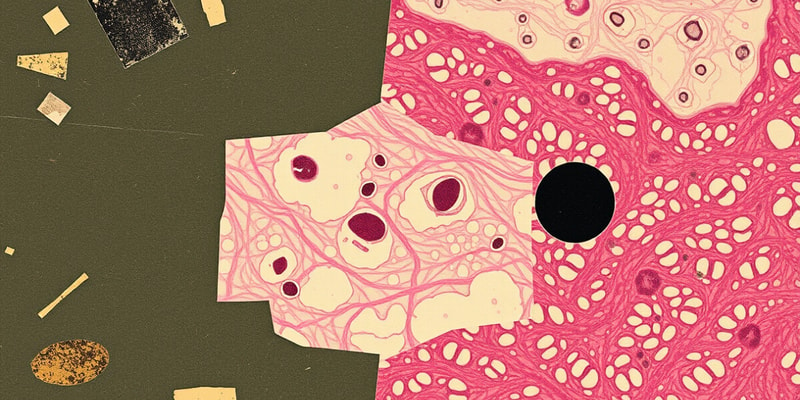Podcast
Questions and Answers
Which tissue type is primarily responsible for the secretion of substances?
Which tissue type is primarily responsible for the secretion of substances?
What is the primary function of connective tissue?
What is the primary function of connective tissue?
From which embryonic germ layer does the skin primarily develop?
From which embryonic germ layer does the skin primarily develop?
Which type of epithelial tissue is best suited for absorption?
Which type of epithelial tissue is best suited for absorption?
Signup and view all the answers
Which type of gland releases substances directly into the bloodstream?
Which type of gland releases substances directly into the bloodstream?
Signup and view all the answers
Which characteristic is NOT true for epithelial tissues?
Which characteristic is NOT true for epithelial tissues?
Signup and view all the answers
Which epithelial cell shape is best suited for secretion processes?
Which epithelial cell shape is best suited for secretion processes?
Signup and view all the answers
What distinguishes pseudostratified epithelium from simple epithelium?
What distinguishes pseudostratified epithelium from simple epithelium?
Signup and view all the answers
Which type of gland is characterized by being ductless and releases hormones directly into the bloodstream?
Which type of gland is characterized by being ductless and releases hormones directly into the bloodstream?
Signup and view all the answers
Which epithelial tissue type provides a thick protective barrier and would likely have flat, multiple layers of cells?
Which epithelial tissue type provides a thick protective barrier and would likely have flat, multiple layers of cells?
Signup and view all the answers
Study Notes
Tissues: The Building Blocks of the Body
- Tissues are collections of cells and their surrounding extracellular material, forming distinct structures with specific purposes.
- Histology is the microscopic study of tissues.
The Four Primary Tissue Types
-
Epithelial Tissue: Covers body surfaces and lines cavities.
- Functions: Protection, barrier formation, substance passage, secretion, and absorption.
- Key characteristics: Composed mostly of cells, has an exposed surface, attaches to a basal surface, has cellular connections, is avascular (no blood vessels), and can regenerate.
-
Classification:
- Layers: Simple (one layer), stratified (multiple layers), pseudostratified (appears layered but all cells are connected to the basement membrane).
- Shape: Squamous (flat), cuboidal (cube-shaped), columnar (column-like).
- Cell Modifications: Keratinization (presence of keratin, a tough protein), cilia (hair-like projections).
-
Connective Tissue: Supports and connects other tissues.
- Functions: Support, enclosure, connection, storage, cushioning, insulation, and transport.
- Origins: All connective tissue develops from mesenchyme, an embryonic connective tissue derived from mesoderm.
-
Components:
- Specialized Cells: Varying types depending on specific connective tissue.
-
Extracellular Matrix:
- Protein fibers: Collagen (strength), reticular (fine network), elastic (stretch).
- Ground substance: Liquid (blood) or solid (bone).
-
Muscle Tissue: Specialized for contraction.
-
Types:
- Skeletal Muscle: Striated, voluntary (conscious control).
- Cardiac Muscle: Striated, involuntary (unconscious control).
- Smooth Muscle: Unstriated, involuntary (unconscious control).
-
Types:
-
Nervous Tissue: Specialized for communication using electrical signals.
- Found: Within the nervous system (brain, spinal cord, nerves).
- Components: Neurons (nerve cells) and glial cells (supporting cells).
Germ Layers: The Embryonic Origins of Tissues
- During embryonic development, three germ layers form:
- Endoderm: Develops into the lining of the digestive tract.
- Mesoderm: Gives rise to organs, muscles, bones, and blood vessels.
- Ectoderm: Forms the skin and nervous system.
Glands: Secreting Structures
-
Endocrine Glands:
- Ductless.
- Release hormones directly into the bloodstream.
- Examples: Growth hormone, testosterone, insulin.
-
Exocrine Glands:
- Have ducts.
- Release products into a body cavity or onto the skin surface.
- Examples: Sweat, digestive enzymes, sebum.
- Further classified by structure:
- Unicellular glands: Goblet cells.
- Multicellular glands: Sweat glands.
Inflammation: The Body's Response to Injury
-
Effects:
- Release of chemical mediators.
- Increased blood flow to the injured area.
- Decreased blood flow out of the injured area.
- Increased vascular permeability (leakiness of blood vessels).
- Increased presence of immune cells and antibodies.
-
Signs:
- Rubor (redness).
- Calor (heat).
- Tumor (swelling).
- Dolar (pain).
- Loss of function.
Tissue Repair: Regeneration and Fibrosis
- Regeneration: Damaged tissue is replaced by the same tissue type.
- Fibrosis: Damaged tissue is replaced by scar tissue.
-
Tissue Types by Regenerative Ability:
- Labile cells: Continue to divide throughout life. Example: Bone marrow.
- Stable cells: Don't usually divide but can be stimulated to do so. Example: Liver cells.
- Permanent cells: No ability to replicate. Examples: Cardiac muscle, nerve cells.
Summary of Tissue Repair
-
Process:
- Inflammation: Initial response to damage.
- Organization: Clean-up and formation of granulation tissue.
- Regeneration and Fibrosis: Replacement of damaged tissue.
Studying That Suits You
Use AI to generate personalized quizzes and flashcards to suit your learning preferences.
Related Documents
Description
Explore the fascinating world of tissues, the vital building blocks that form the structures of the body. This quiz covers the four primary tissue types, focusing on epithelial tissue's characteristics, functions, and classifications. Test your knowledge of histology and the role of tissues in maintaining bodily functions.




